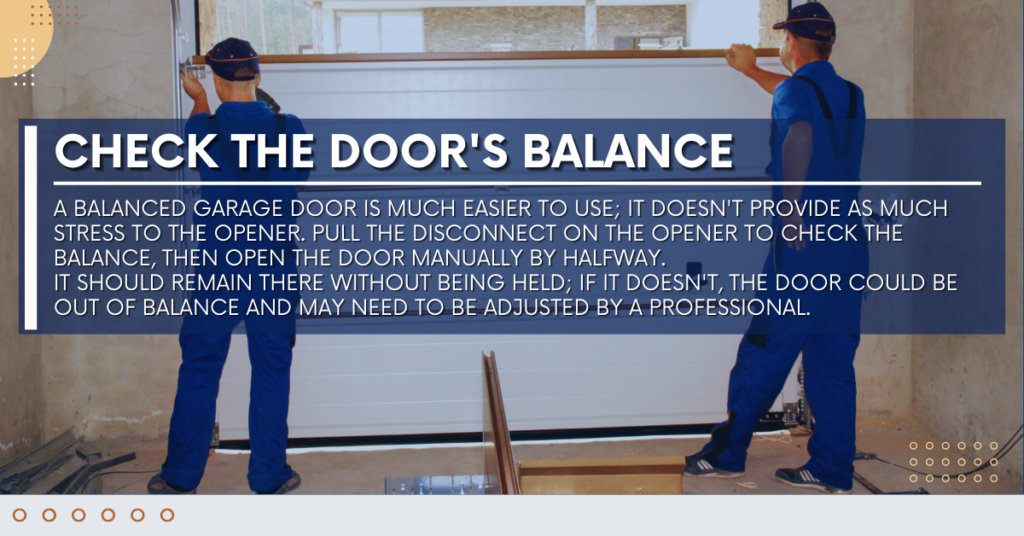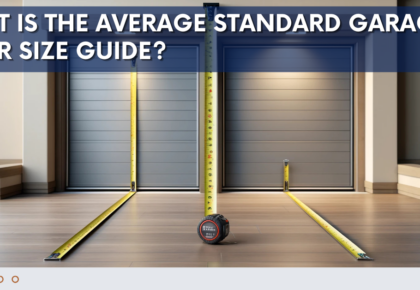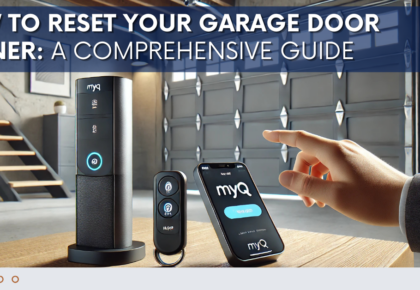A wide-open garage door can be both a huge nuisance upon and hassle in one’s daily life. This also exposes your home to several threats.
Learn some of the things that may well be making this happen, and how to diagnose it in a way to save loads of time, money, and frustration.
Here are only some of the reasons your garage door refuses to go up, with some plain common sense solutions to get things moving once again.
Why Won’t My Garage Door Open?
1. Power source problems
First of all, if the garage door won’t open, then one will need to check with the power source. First, ensure that your garage door opener is plugged well into a functioning outlet. Primer times it happens are usually because of tripping the breaker or blowing off fuses in your circuit.
2. Problems with remote controls
Some of the very common reasons behind a garage door that won’t open from the garage side include defects in the remote control.
First, change your batteries. Drive up to an opening in the doors of the garages while having your remote on with no obstruction in the line.
If none of the above works, then most probably your remote needs reprogramming. Go to the manual of your garage door opener on how to reprogram it.
3. Sensor Failures
These are fitted with safety sensors on modern garage doors that won’t close if something is standing in their line of sight.
Dirty or unaligned sensors could prevent their opening.
Check that the sensors are very clean and in their normal positions; otherwise, clean them when action at this step does not work. Check for wiring in case it is not perfectly intact.
4. Fractured Springs
The garage doors work systematically with torsion spring functionality or extension springs, exposing an individual to it in terms of lifting and lowering.
The same, however, is prone to wear and tear or even breakage, something that might render the garage door stuck.
There is the feeling that something has gone wrong with spring and calls for a professional to be consulted.
On top of the list of reasons behind not opening a garage door are broken springs; these will have to be cared for by expert technicians since they can be fairly dangerous.
5. Faulty/Unplugged cables
These can include the cables that are on the springs. In case these cables rupture or in any other way loosen up, this would not open, period. You should examine your cables for fraying or wear.
Anyway, in the event that you see such cables fraying or having a break under any circumstance, it is best that you call on a professional and have such cables replaced.
6. Obstacles in the Track
These garage door tracks should be clean and free of any particles. See if the tracks have dents in them or if they are clogged up or ruined.
Place a level beside the tracks to see that it is straight, and if the framework does not, tap them into the right position using a rubber mallet. All of these will work magic with a good cleaning, and a little inspection work avoids quite a few common problems related to garage doors.
Steps in Troubleshooting a Stuck Garage Door
1. Inspect the door tracks
Wipe the tracks clean with a damp cloth to clear off any dirt or other material that may be affecting the door. If there are dents or other damage, use a rubber mallet to tap the tracks
gently back in place.
Some cases may require you to loosen the bolts that hold the tracks and make adjustments manually.
2. Inspect the Springs
Springs are a part of your garage door system. In case they are broken or worn out, the door won’t work at all. If you hear a loud bang or see that the door seems uneven, then it probably has broken springs. You can’t replace them on your own; this requires special tools and knowledge.
3. Apply lubricant to moving parts
Most problems of a common nature may be avoided by regular maintenance, and it is definitely essential to lubricate all of the moving parts on your garage door.
Take advantage of a first-class garage door lubricant on rollers, hinges, and tracks for smooth functioning. Avoid heavy grease because it attracts dust and particles that bring other problems.
4. Reversing: Test the Auto-Reverse Feature
The auto-reverse prevents the door from closing on an object or a person.Place a small object in the path of the door, and attempt to close it.
In case the door doesn’t reverse upon contact, then adjustment or repair on this feature is needed.
This test should be performed monthly to ensure your garage door system is safe.
Preventive Maintenance Tips
1. Regular Inspection and Maintenance
Most issues associated with garage doors can be avoided with regular inspection and maintenance.
Ensure your door is balanced: Turn off the door opener and operate the door manually.
2. Clean Tracks
Dirty or clogged tracks could hamper the movement of your garage door. Clean the tracks with a soft, damp cloth and clear off any debris on a regular basis.
Avoid the use of harsh chemicals that might further pit the tracks. Keep the tracks clean and clear of debris for smooth operation of your garage door.
3. Lubricate Moving Parts
So, it is rather imperative to lubricate the moving parts of your garage door so that wear and tear might be evaded. Silicone-based lubricants, applied to rollers, hinges, and tracks every six months, will help in lubrication.
This will reduce friction and increase the life of your garage door system.
4. Inspect and Tighten Hardware
Over time, the hardware on your garage door can loosen. Check the bolts and screws regularly for needed tightening.
Pay special attention to the brackets that hold the tracks in place. Failure to do so allows loose brackets, which are.MIN supporting this misadjustment of the tracks:.
5. Check the door’s balance

A balanced garage door is much easier to use; it doesn’t provide as much stress to the opener. Pull the disconnect on the opener to check the balance, then open the door manually by halfway.
It should remain there without being held; if it doesn’t, the door could be out of balance and may need to be adjusted by a professional.
Advanced Techniques in Troubleshooting
1. Resetting a Garage Door Opener
Sometimes, you can simply reset a malfunctioning opener. Refer to your opener manual for instructions on how to do a reset.
For most of the designs, this simply involves unplugging the unit, waiting for about a minute or two, before plugging it back in. The opener is thus reset off those glitches or errors found in the system.
2. Checking the Cables
Cables are another integral part of the mechanism of a garage door. Check cables for any wear, fraying, or damage.
In case of any flaws, replacement should be done by a professional since dealing with cables can be dangerous. Chances of unwarned failures exist when cables are regularly inspected and maintained.
3. Logic board check
This circuit board controls the operation of the garage door opener. If all other troubleshooting has taken place and none of it is working, then the logic board is to blame.
This typically requires professional diagnosis and replacement. A malfunctioning logic board can be the reason why an opener acts erratically or doesn’t at all, in the case of a garage door.
4. Checking the Limit Settings
Travel limits are a function of the garage door opener that dictate how far the garage door will travel once it is set to open and close. This could be your problem if it doesn’t seem to travel completely up/down properly.
Consult your owner’s manual to know how to adjust the limit settings. Limit settings, when properly adjusted, guarantee that the door opens and closes without problems and fully.
5. Roller Inspection
The rollers assist in the smooth movement of the garage door along the tracks. In time, after several uses, something can wear or even get damaged, including the door that holds the door.
Now, start inspecting the rollers and replace the ones that need to be replaced. Using nylon rollers is good since they will dampen the noise and make your garage door opener work more smoothly.
When to Call in a Professional
1. Identification of complex problems
While most problems associated with the garage door can be repaired using DIY methods, there are others that do require professional intervention. If you have done all of the above steps to no avail the door still won’t open or if it is visibly damaged with broken parts, then it’s time to seek professional help.
It then leaves the professionals with the equipment and experience to diagnose and repair such complex problems in a safe and efficient manner.
2. The Safety First rule
The garage doors are extremely heavy, while most mechanisms that support them are quite complicated. Therefore, due to safety reasons, do not try to repair by yourself when the problem concerns the springs, cables, or openers’ motors.
These repairs should only be done by properly accessorized and trained pros for safe processing. Trying to do this with no training comes with serious injuries and further damages to your garage door system.
3. Warranty Considerations
In case your garage door or its opener is still under warranty, then a few do-it-yourself repairs could translate into the warranty becoming null. Do not attempt any repair without checking on the warranty conditions first. Most professional repairs are covered under warranty and thus shall be properly done and you’ll not need to bear any extra cost.
4. Routine Professional Maintenance
Equally, consider scheduling routine maintenance with professional technicians in garage doors, and they will perform a detailed inspection on your door, together with probable adjustment needs for it to remain in top working order.
In fact, this periodic examination by a professional not only extends the lifespan of a garage door but also saves from large expenses which have to be incurred on high-cost repair work.
Conclusion
If your garage door won’t open, it isn’t such a hassle anymore. Knowing some of the common causes and stepping through a truly simple troubleshooting process can put you back in business relatively quickly.
The keys to making a garage door work effectively over its intended long service life are regular maintenance and help from professionals in a timely manner.
Most of the issues with garage doors can be considerably brought back to life through many of these tips being done on a regular basis to ensure smooth and reliable operation for decades.
FAQs
Why is my garage door stuck halfway?
If the door tends to get stuck halfway, then this problem may originate in the springs, cables, or even tracks. Seek any damage or obstruction with these components.
How often do you grease your garage door?
Slap lubricant on an assignment to every one of the moving parts of your garage door every six months.
Will I be able to open the garage door manually if the opener stops working?
Indeed, most of the time, garage doors have a manual release handle that one can use to open the door in such cases. Refer to your door’s manual for instructions.
What should I do if an alarm beeps from the garage door opener?
A beeping garage door opener most commonly indicates that it has a low battery, is detecting an obstruction, or needs adjustment with its maintenance. All tips for troubleshooting are model-specific to the openers, so refer to your specific opener’s owner’s manual.
How Do I Keep My Garage Door from Sticking?
Keeping the track clean, lubricating the moving parts, or replacing them in terms of periodic wear and tear can keep your garage door in good condition and avoid impaction.
What are some of the indications of your automatic garage door opener failing?
Some of the signs and symptoms to replace a failing garage door opener are slow or jerky movement, unusual noises, and when the door won’t respond to remote commands. Replace your opener when such issues are noted in the first place.
Is it safe to repair garage door springs myself?
No, repairing garage door springs on one’s own is just so dangerous. They are kept under an incredibly high tension, which means it would be best if you spent the money to have a professional replace your broken spring.
Why will my garage door only close part way and then reverse?
This may be due to misaligned or blocked sensors. Clean and realign the sensors to work correctly.
Can the weather mess with my garage door?
Yes, extreme temperatures can affect lubrication and the running of your garage door. This again can be curtailed by regular maintenance and proper lubrication.
Specifically, how do I better secure my garage door?
Consider a rolling code garage door opener; the code changes with every remote use. Also, keep in mind the servicing of your garage door every now and then and removing weak points.








